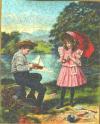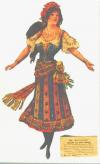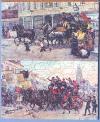The first great period for puzzles cut for grownups is called the “1909 era”. It began in Eastern Massachusetts in 1907 when a young woman (whose name has been lost) began cutting colorful magazine covers into 100-200-piece puzzles and selling them at fairs to benefit a children’s hospital. This touched off a craze that spread to Boston and then to New York and other major American cities by Spring 2008, and across the Atlantic to London by 1909. The craze continued for another couple of years, marked by mostly women cutters making non-interlocking puzzles cut from solid wood along the color lines in the picture with treadle scroll saws. They generally selected appealing pictures and cut extraordinarily difficult puzzles. These traditions played out over the next two decades, as quality plywood rapidly became more available, power scroll saws were developed, assemblers demanded more interlocking puzzles with figure pieces (look like recognizable objects) and men entered the business.
Mrs. Richardson made many wonderful traditional puzzles in New York City between 1908 and 1910, but also this unique puzzle for its time, designed, hand illustrated and cut along color lines without any spaces so that everyone of its 90 pieces resembles an animal, many highly imaginary. This is the first known example of a "cluster puzzle" based on the true tessellation principle without any gaps or overlaps, a type of puzzle not seen again until the 1930's
Vivid colors, appealing scene, solid wood, excellent color line cutting make this a great puzzle and one of our favorites. When will our sailor boy, engrossed in his model sailboat, realize a very pretty girl desires his attention?
This solid wood puzzle is a dramatic example of highly irregular border cutting, in this case exactly around the central figure. To display it, I traced the puzzle outline onto foam board and used a spiral blade (which cuts in any direction) to cut out the outline before gluing it onto another piece of foam board and finally inserting the puzzle. Even with a superior saw and blade, and a magnifying glass, I had trouble duplicating the Holtzapffel cutting, especially in the fringes of the scarf.
"Badinage", is an old term meaning "playful humor or banter", and that is exactly what appears to be going on in this scene. Solid wood, cut extensively along color lines. An extremely difficult puzzle because of all the green background. Note: "hour glass” figure of a “Gibson Girl”, the result of a tight corset worn by women at the turn of the century which were probably made in Worcester, MA. Artist is unknown.
Most unusual portrayal by artist M. Granville Smith of women playing rugby football before a crowd in 1894. Puzzle (along with the two of us and leading American jigsaw puzzle expert, Anne Williams) was featured on PBS History Detectives in July 2003 exposing scene as a fantasy. Picture was centerfold in 1894 football issue of Truth, a risqué magazine designed to "titillate gentlemen" in the 1890s. Scenes depicting the "Gibson girl" (lovely women performing unusual, athletic, adventurous activities) form one of our most popular special collections. Cut along color lines.
Very unusual with double scenes from Ludovici’s Dickens coaching series: "D14 The Pickwickians Leave the Golden Cross for Rochester" (top), "D16 The Pickwickians Arrive at Eatanswill" (bottom). Scenes are based on Dickens' Pickwick Papers. Cut with 48 figure pieces. Only multiple Zag-Zaw of Ludovici’s Dickens coaching scenes known to exist. We collect all 16 of his scenes cut individually into puzzles by Parker Brothers and Raphael Tuck and displayed in the giant Full of the Dickens puzzle in this exhibit.
Unknown artist has taken liberty with Shakespeare’s Othello to portray the evil Iago (instead of his wife, Emilia) stealing Desdemona’s handkerchief. Puzzle was part of the “Shakespeare in American Life” exhibition celebrating the 175th anniversary of the Folger Shakespeare Library in Washington, DC 2007. Someday soon, our collection of Shakespeare scene puzzles will go to the Folger.
Double cut so multiple pieces fit into 2 places, color line cut, altogether a dastardly puzzle! Artist is M. Malony. A big restoration job for Bob with 11 replacement pieces. The story from Greek mythology is: as condition to end the conflict between Athens and Crete, Athens had to pay a yearly tribute of 14 youths to be fed to the Minotaur which Minos, King of Crete, housed in a labyrinth on Crete. Athenian hero Theseus pledged to his father, Argeus, King of Athens, that he would kill the Minotaur and free his people from the wrath of Minos. Theseus went to Crete where Ariadne, daughter of King Minos, fell in love with him and gave Theseus a ball of silk thread to unwind through the endless maze of wandering paths in the labyrinth. Theseus slayed the Minotaur (he has just mortally wounded the beast), followed the thread out (note ball of thread in his hand) and set sail for Athens with Ariadne, freeing Athens from the yearly tribute.
Wonderful sympathetic portrayal of an elderly Black couple, also by the artist Harry Roseland, suggesting he was “ahead of his time” with his view of Black people. Color line cut from solid wood.
Strong appeal of this scene by unknown artist makes a very special puzzle. Puzzle maker Clara Rawson had impeccable taste for artwork. Solid wood, cut extensively along color lines. This puzzle came with 7 “so-so” replacement pieces, replaced by me because the scene is so appealing. Can you find any?








![[Elderly couple]](https://www.oldpuzzles.com/files/styles/thumbnail_100w/public/examples/1798_1.jpg?itok=nrliT9RS)
![[The Kiss]](https://www.oldpuzzles.com/files/styles/thumbnail_100w/public/examples/1773_1.jpg?itok=UHQLAfVn)